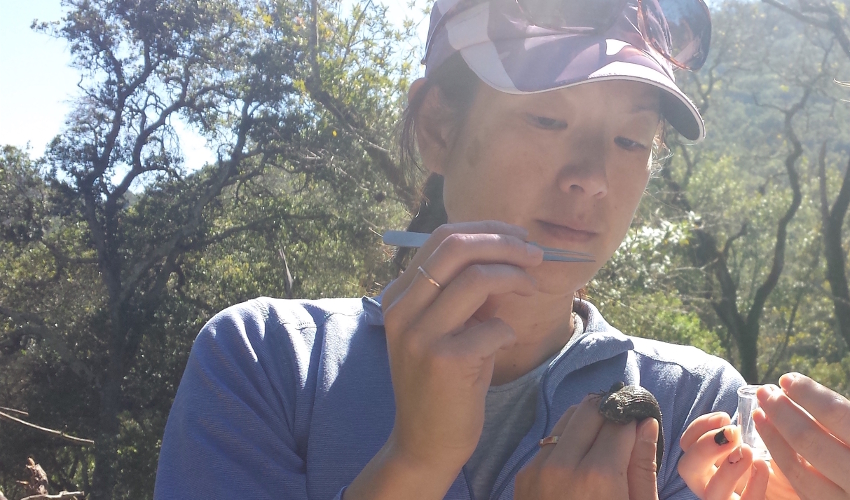Biologists at SF State dig into ticks and Lyme disease

Professor Andrea Swei prepares to pull a tick off a western fence lizard.
East Coast gets the limelight, but California’s ticks play by different rules
Lots of things probably come to mind when you think of Lyme disease, but California likely isn’t one of them. Most of the human cases of Lyme — and most research studies on it — happen in the northeastern U.S. But new work from San Francisco State University Biology Professor Andrea Swei and her former graduate student Jessica Kwan shows that the West Coast may have a thing or two to teach the East about the disease.
“The West Coast has been largely ignored,” said Swei. “And I think that’s a mistake.”
For Swei, California’s lower prevalence of Lyme is an opportunity to probe how the bacteria that causes the disease spreads differently on the West Coast. One leading explanation has to do with the different hosts that Lyme-carrying ticks prefer. In the Northeast, young ticks like to feed on the blood of small mammals like mice and chipmunks. In California, however, they have another favorite: western fence lizards. These lizards have unique blood that actually kills off the Lyme bacteria present in ticks, essentially un-infecting them.
That got Kwan thinking. If the Lyme disease bacteria dies when its host feeds on a lizard, what happens to all the rest of the tick’s microbial residents? After all, the whole community of microbes in a tick — what scientists call its “microbiome” — could affect whether Lyme-causing bacteria thrive.
The team, with Kwan at the helm, captured western black-legged ticks from around Marin County both by dragging nets through vegetation and by pulling them off lizards. They also raised some in the lab. The team then tested tens of millions of snippets of bacteria DNA from the ticks and organized these snippets by how similar they were to one another. That gave them an idea of the diversity of microbial life that was living in each tick, and how that diversity changed over the ticks’ lives.
They found that ticks harboring a less diverse community of microbes were more likely to be infected with the Lyme pathogen, and that those microbe communities actually became less diverse as the ticks fed and grew. This came as a surprise — both findings ran counter to research done back east. “We were thinking in the East Coast model,” explained Kwan. California ticks, apparently, play by different rules.
The results also hint at a more complicated role for western fence lizards in the transmission of Lyme. “They’ve been touted as this secret weapon against the Lyme disease bacteria,” Swei explained. But if they make the whole microbiome of a feeding tick less diverse, that tick may actually be more likely to harbor and spread the bacteria that causes the disease.
Swei and her team plan to keep on probing the unique California Lyme disease system. Armed with new data, they’ll keep investigating this more complicated picture of the western fence lizard’s role. They even plan to look at how different strains of the same species of Lyme-causing bacteria could change how the disease spreads. “There’s a lot we can still learn from the system here,” says Swei.
The work was published on Nov. 28 in the journal Molecular Ecology and was funded by the National Science Foundation.